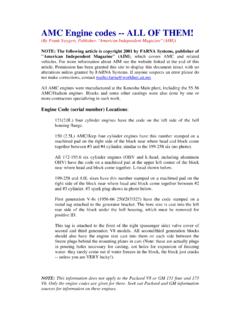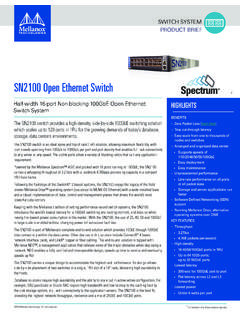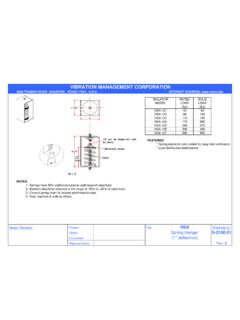Transcription of Motorcraft 2100 Jeep AMC - street2mud.com
1 Motorcraft 2100 jeep AMC See instructions at the end- click Model 2100 carburetor is a two venturi carburetor which incorporates two lightweight aluminum assemblies, the air horn and the main body. The air horn assembly serves as the main body cover and also contains the choke assembly and fuel bowl vents. The throttle shaft assembly and all units of the fuel metering systems are contained in the main body assembly. The automatic choke assembly and the dashpot are attached to the main body (Fig. 1). The carburetor is identified by a Code and build date which is stamped on the code tag.
2 Each carburetor build month is coded alphabetically begin-ning with the letter "A" in January and ending with the letter "M" in Decem-ber. However, the letter "I" is not used. The tag is attached to the carbu-retor and must remain with the car-buretor to assure proper identification (Fig. 2). CARBURETOR SYSTEMS The Model 2100 carburetor utilizes four basic fuel metering systems,- The CARBURETOR-MODEL 2100 Idle Limiter Cap Power Valve Accelerator Pump 70190 FIGURE 1 Carburetor Assembly Idle (Low Speed) System, provides a fuel-air mixture for idle and low speed performance, the Main Metering (High Speed) System, provides an econom-ical mixture for normal cruising speeds,-the Pump System, provides additional fuel during low speed acceleration,-and the Power Enrichment System, provides a very rich mixture when high power output is needed.
3 In addition to these four basic metering systems, the carburetor con-tains a Float (Fuel Inlet) and Choke system. Float (Fuel Inlet) System Fuel under pressure enters the fuel bowl through the fuel inlet fitting in the main body. The "Viton" tipped fuel inlet needle is controlled by the float and lever assembly which is hinged on a float shaft. A wire retainer is hooked over FUEL-CARBURETION 4-3-2 Code liver the proper mixture to the engine. The amount of fuel entering the bowl is regulated by the distance the fuel inlet needle is raised off its seat. The float drops as the fuel level drops and raises the fuel inlet needle off its seat.
4 This permits additional fuel to enter the bowl past the fuel inlet needle. When the fuel reaches a pre-set level, the fuel inlet needle is lowered to a position where only enough fuel is admitted to replace that being used. Build Date FIGURE 2 - Code Tag Identification Idle (Low Speed) System grooves on opposite ends of the float shaft and into a groove behind the fuel inlet needle seat. The retainer holds the float shaft firmly in the fuel bowl guides and also centers the float assembly in the fuel bowl. An integral retaining clip is hooked over the end of the float lever and attached to the fuel inlet needle.
5 This assures reaction of the fuel inlet needle during downward movement of the float (Fig. 3). The float system maintains a speci-fied fuel level in the bowl, enabling the basic fuel metering systems to de-Fuel for idle and low speed opera-tion flows from the fuel bowl through the main jets into the main wells. From the main wells, the fuel is metered as it passes through-calibrated restrictions at the lower end of the idle tubes. After flowing through the idle tubes, the fuel enters diagonal passages above the tubes. The fuel is metered again as it flows downward through restrictions at the lower end of the diagonal passages and then enters the idle passages in the main body (Fig.)
6 4). Air enters the idle system through air bleeds which are located in the main body directly below the booster ven-turi. The air bleeds serve as anti-siphon vents during off-idle and high speed operation, and when the engine is stopped. The fuel-air mixture moves down the idle passages past the idle transfer slots which serve as additional air bleeds during curb idle operation. The fuel-air mixture then moves past the idle mixture adjusting screw tips which control the amount of discharge. From the adjusting screw ports, the fuel-air mixture moves through short hori-zontal passages and is discharged below the throttle valves.
7 At speeds slightly above idle, the idle transfer slots begin discharging the fuel-air mixture as the throttle valves expose them to manifold vacuum. As the throttle valves continue opening and engine speed increases, the air flow through the carburetor increases proportionately. This increased air flow creates a vacuum in the venturi and the main metering system begins dis-charging a fuel-air mixture. The dis-charge from the idle system tapers off as the main metering system begins discharging. Fuel Bowl Fuel Float Fuel Inlet Needle and Seat Assy. FIGURE 3 - Float System Main Metering (High Speed) System As engine speed increases, the air velocity through the booster venturi creates a vacuum (low pressure area).
8 Fuel begins to flow through the main metering system due to the high pres-sure in the fuel bowl and low pressure at the main discharge ports, fuel flows from the fuel bowl, through the main jets, and into the main wells. The fuel then moves up the main well tubes where it is mixed with air. The air, sup-plied through the main air bleeds, mixes with the fuel through small holes in the sides of the main well tubes. The main air bleeds meter an increasing amount of air, whenever venturi vac-uum increases, to maintain the proper fuel-air ratio. The mixture of fuel and air, being lighter than raw fuel, re-sponds quickly to changes in venturi vacuum.
9 It also atomizes more readily than raw fuel. The fuel-air mixture moves from the main well tubes to the discharge ports and is discharged into the booster ven-turi (Fig. 5). Venturi Trans. Engine Model Year Revision Letter 2 D A 2 Vendor Check-Letter Year Month Day 2B 15 A 4-3-3 FUEL-CARBURETION Anti-siphon air bleeds, located near the top of the main well tubes, prevent siphoning of fuel from the main well when decelerating. Pump System When the throttle valves are opened quickly, the air flow through the carbu-retor responds almost immediately. However, since the flowing fuel is heavier than air, there is a brief lag in time before the fuel flow can gain speed enough to maintain the proper fuel-air ratio.
10 During this lag, the pump system supplies the required fuel, until the proper fuel-air ratio can be maintained by the other metering systems (Fig. 6). When the throttle valves are closed, the diaphragm return spring exerts force against the diaphragm and pushes it against the cover. Fuel is drawn through the inlet, past the Elastomer valve and into the pump chamber. A discharge check ball and weight prevents air from being drawn into the pump chamber. When the throttle valves are opened, the diaphragm rod is pushed inward, forcing fuel from the pump chamber into the discharge passages.







